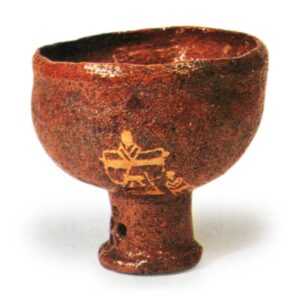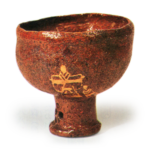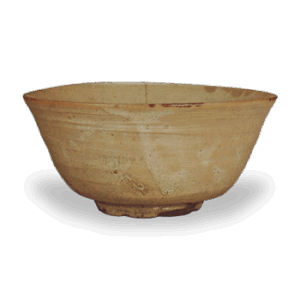
Raku ware from Kaga (Ishikawa Prefecture), a side kiln. 1666 (Kanbun 6), Maeda Tsunanori, lord of the Kaga domain, invited Sen Soshitsu (Sen), the fourth generation of the Urasenke school, and Chozaemon (first name Choji), a Raku potter, to build an earthenware kiln in 1686 (Jokyo 3) in Ohi-cho, Kanazawa, and had Chozaemon produce matcha vessels. At this time, Chozaemon took the name of the place as his family name, and this was the foundation of Ohi ware.
Chozaemon’s ancestor was Chozan Yasutoshi, a miscellaneous handler who served Sugawara no Michizane during the Kanpei period (889 SEU oil 198). After Michizane’s exile, he settled in Doji Village in Kawachi Province (Osaka Prefecture) and followed the pottery business under the family name of Doji. Chozaemon, the 23rd generation, went to Kyoto in 1656 (Meireki 2) to follow Raku Kichizaemon (Iryu) in his Raku pottery business, and was later invited to join the Kaga domain. His descendants, Chozaemon II, Kanbei III, Kanbei IV, Kanbei V, Sakutaro VI, and Michitada VII, succeeded him, and he served the Kaga domain as a Gosakuji-kata Okabe-sho (official in charge of tea ceremony equipment) and supplied them with tea utensils. The business was temporarily suspended when the domain was abolished in the Meiji era (1868-1912), but in 1884 (Meiji 17), the kiln was re-opened in Kanazawa Kasuga-machi. However, his performance was not good, and in 1897, he handed over the business to Nara Rikichi, and Ohi-yaki was no longer part of the official lineage. Ohi ware is characterized by its dense clay, similar to Akaraku, and its glaze is reddish yellow, commonly called Ohi ame-glaze. Some of the early pieces were carved with whorl lines. Nara Rikichi began to enjoy the tea ceremony when he was young, and received his pottery training from Michitada VII, who passed the name of Ohi Chozaemon VIII on to his successor, the ninth generation, in 1927. Of the Ohi generations, Kanbei V is second only to the first in skill. During the period of Bunka-Bunsei (1804-30), when the Kaga Clan’s craftsmanship was at its peak, Kanpei V demonstrated his skills in Raku ware, which had been handed down in his family, and also produced various types of molds and overglaze enameled ware, and was called a master craftsman of the modern era. Asano ware is a well-known pottery that is a close relative of Ohi ware. (Honcho Toki Novela, Kogei Shiryo, Prefectural Pottery History and Potters’ Traditions, Kogei Kagami, Toki Rui Shu, Catalogue of Japanese Ceramics, Taisei Toki, Matsumoto Sataro)








